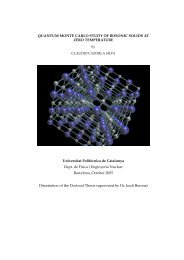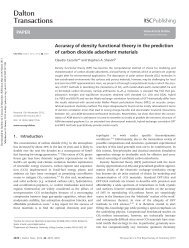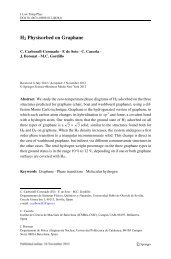Journal of Physics: Condensed Matter 22, 165402 - DR. CLAUDIO ...
Journal of Physics: Condensed Matter 22, 165402 - DR. CLAUDIO ...
Journal of Physics: Condensed Matter 22, 165402 - DR. CLAUDIO ...
Create successful ePaper yourself
Turn your PDF publications into a flip-book with our unique Google optimized e-Paper software.
Home Search Collections <strong>Journal</strong>s About Contact us My IOPscienceGround-state properties and superfluidity <strong>of</strong> two- and quasi-two-dimensional solid 4 HeThis article has been downloaded from IOPscience. Please scroll down to see the full text article.2010 J. Phys.: Condens. <strong>Matter</strong> <strong>22</strong> <strong>165402</strong>(http://iopscience.iop.org/0953-8984/<strong>22</strong>/16/<strong>165402</strong>)The Table <strong>of</strong> Contents and more related content is availableDownload details:IP Address: 144.82.100.71The article was downloaded on 05/04/2010 at 11:27Please note that terms and conditions apply.
J. Phys.: Condens. <strong>Matter</strong> <strong>22</strong> (2010) <strong>165402</strong> C Cazorla et alFigure 5. Diffusion <strong>of</strong> the center <strong>of</strong> mass <strong>of</strong> quasi-2D solid 4 Hecalculated at the density ρ = 0.470 σ −2 and different values <strong>of</strong> theatomic z-spatial fluctuations 〈z 2 〉.Table 1. Calculated superfluid fraction (expressed in %) <strong>of</strong> quasi-2Dsolid 4 He as a function <strong>of</strong> the density <strong>of</strong> particles and atomic spatialz-fluctuation 〈z 2 〉.〈z 2 〉 1 2 (σ )ρ(σ −2 ) 0.18 0.<strong>22</strong> 0.350.470 0.003(1) 0.16(1) 6.85(1)0.515 0.015(1) 0.010(1) 17.27(1)0.600 0.0 0.009(1) 54.21(1)is always vanishing, which turns out to be consistent withwhat is found in the strictly 2D case. On the contrary,when confinement in the z-direction is shallow, that is thecase where 〈z 2 〉 1/2 = 0.35 σ ,thevalue<strong>of</strong>ρ s /ρ is alwayslarge and increases as the density <strong>of</strong> particles is raised (seetable 1). Results in the last column <strong>of</strong> table 1 appear to show acompetition between in-plane and out-plane interactions; as thesystem is compressed, in-plane repulsive interactions becomeprogressively more important so that atoms prefer to spreadover the z-direction wherein potential confinement is mildand they can move more freely. This has the overall effect<strong>of</strong> enhancing the superfluid response <strong>of</strong> the system. In the〈z 2 〉 1/2 = 0.18 and 0.<strong>22</strong> σ cases, estimated ρ s /ρ trends ondensity are not that monotonic. At 〈z 2 〉 1/2 = 0.18 σ ,weseethat ρ s /ρ first increases when the density <strong>of</strong> particles is raisedwhereas next it diminishes down to zero value under furthercompression <strong>of</strong> the system. This behavior can be understoodin terms <strong>of</strong> the imposed z-axis confinement and atomic inplaneinteractions as well. When the density <strong>of</strong> particles is firstincreased, atoms minimize their potential energy by spanningover the z-axis in order to keep a distance from their neighborsand move as freely as possible. The total space availablefor the atoms then becomes larger so the effective density <strong>of</strong>the system becomes smaller. The value <strong>of</strong> ρ s /ρ consequentlyincreases. However, when density is further raised, out-planeatomic excursions are not favorable any more because largedisplacements along the z-direction require too much energy.The value <strong>of</strong> ρ s /ρ then decreases because atomic motion isFigure 6. Radial pair-distribution function calculated on thexy-plane <strong>of</strong> the quasi-2D film at different densities and fixedamplitude <strong>of</strong> z-fluctuations 〈z 2 〉 1/2 = 0.35 σ . At densityρ = 0.600 σ −2 , the peaks and valleys <strong>of</strong> the g xy (r) function turn outto be appreciably less pronounced than in the other cases considered.tightly bound to the xy-plane and the effective density <strong>of</strong> thesystem becomes large. The competition between in- and outplaneinteractions as modulated by the density <strong>of</strong> particlesis responsible for the enhancement/depletion <strong>of</strong> the observedsuperfluid response <strong>of</strong> the system. At z-axis confinement〈z 2 〉 1/2 = 0.<strong>22</strong> σ ,thetrend<strong>of</strong>ρ s /ρ with density exhibitsan intermediate behavior between that found in the 0.18 and0.35 σ cases.Regarding the stability <strong>of</strong> the quasi-2D solid film, wenote that in all the studied cases crystal-like order has beenfound as witnessed by (i) the marked oscillating shape <strong>of</strong> theradial pair-distribution functions g xy (r) obtained consideringthe projection <strong>of</strong> the atomic positions on the xy-plane (seefigure 6), and (ii) the peaked pattern <strong>of</strong> the corresponding radialaveraged structure factors S xy that scale with the number <strong>of</strong>atoms (see figure 7). Nevertheless, in the 〈z 2 〉 1/2 = 0.35 σcases the film is likely to be a kind <strong>of</strong> glass system since thevalues <strong>of</strong> the corresponding maximum S xy (k) peaks are small(see figure 7, lower panel) and the ρ s /ρ values obtained arequite large (last column in table 1) in comparison to the resultsobtained upon tighter z-confinement. In fact, large superfluidfractions (∼10–60%) have been estimated in metastable 4 Heglass systems using the PIMC method [9]. Moreover, wehave calculated the total energy <strong>of</strong> a quasi-2D liquid systemat the same density and 〈z 2 〉 1/2 conditions as in the quasi-2Dsolid system, using a Jastrow factor and Gaussian z-localizingfactors as importance sampling. It is found that in all the〈z 2 〉 1/2 = 0.35 σ cases the quasi-2D solid film is metastable(that is E q−2DJ< E q−2DSNJ) whereas it is stable in the rest<strong>of</strong> 〈z 2 〉 1/2 and ρ cases (that is E q−2DSNJ< E q−2DJ). Forinstance, at 〈z 2 〉 1/2 = 0.35 σ and ρ = 0.515 σ −2 we obtainE q−2DJ= 2.71(2) K/atom and E q−2DSNJ= 3.66(2) K/atom,while at 〈z 2 〉 1/2 = 0.18 σ and the same density we obtainE q−2DJ= 16.29(3) K/atom and E q−2DSNJ= 15.81(2) K/atom.This last outcome, in analogy with the 3D case, appearsto corroborate the hypothesis that the results obtained at6
J. Phys.: Condens. <strong>Matter</strong> <strong>22</strong> (2010) <strong>165402</strong> C Cazorla et alFigure 7. Calculated radial averaged structure factor S xy (k) <strong>of</strong> thequasi-2D solid film at ρ = 0.515 σ −2 (k is in units <strong>of</strong> σ −1 ). Solidlines represent calculations performed with N = 120 atoms, dashedlines calculations performed with N = <strong>22</strong>4 atoms and trianglescorrespond to results obtained for a quasi-2D liquid system(N = 120 atoms). In the lower and upper panels, we show resultsobtained for z-confinement 〈z 2 〉 1/2 = 0.35 σ and〈z 2 〉 1/2 = 0.<strong>22</strong> σ , respectively.Figure 8. Calculated atomic z-density pr<strong>of</strong>ile (solid line) in thequasi-2D solid system at ρ = 0.470 σ −2 and 〈z 2 〉 1/2 = 0.18 σ .Forcomparison, we plot the corresponding normalized Gaussianz-localizing factor (χ = 16 σ −2 ) entering trial wavefunction q−2DSNJ.The distance is in units <strong>of</strong> σ .z-confinement 〈z 2 〉 1/2 = 0.35 σ correspond to quasi-2Dglass systems.It is worth noticing that although particles in the quasi-2D film are allowed to move in the z-direction, there isnot enough energy to excite the levels <strong>of</strong> the transverseconfinement and the system is kinematically two-dimensional.The radial motion is frozen to zero-point oscillations andthe magnitude <strong>of</strong> z-fluctuations therefore is related to thelength 〈z 2 〉 1/2 . We illustrate this in figure 8 where weplot the atomic z-density pr<strong>of</strong>ile calculated in the quasi-2Dsolid film at ρ = 0.470 σ −2 and 〈z 2 〉 1/2 = 0.18 σusing the pure estimators technique [23] and compare it withthe corresponding normalized Gaussian z-localizing factorentering q−2DSNJ(case χ = 16 σ −2 ).4. ConclusionsWe have studied 2D and quasi-2D solid 4 He at zerotemperature by means <strong>of</strong> the diffusion Monte Carlo method andusing the recently proposed symmetrized trial wavefunction SNJ as importance sampling. We have estimated thesuperfluid density fraction <strong>of</strong> 2D solid 4 He at T = 0andfound that is negligible down to a density <strong>of</strong> ρ = 0.390 σ −2 .Importantly, by allowing the atoms to move along the z-axis, we observe the appearance <strong>of</strong> a superfluid responsethat coexists with the crystalline order <strong>of</strong> the system. Themagnitude <strong>of</strong> this response is shown to depend on the degree<strong>of</strong> z-axis confinement and the density <strong>of</strong> particles. Thisfinding is valuable for the realization and interpretation <strong>of</strong> morerealistic simulations <strong>of</strong> helium layers adsorbed on carbonbasedsurfaces, where the interactions with the substrate mustbe taken into account accurately in order to make rigorousjudgments about the existence <strong>of</strong> superfluidity and/or ODLRO.In view <strong>of</strong> the present results for the quasi-2D solid, it canbe suggested that a well-suited system in which to observea finite superfluid signal is the first layer <strong>of</strong> 4 He on top <strong>of</strong>graphene or graphite [13] which stabilizes in a triangular latticeand possesses relatively small density. Work to verify thishypothesis is in progress.AcknowledgmentsWe acknowledge partial financial support from DGI (Spain)Grant No. FIS2008-04403 and Generalitat de Catalunya GrantNo. 2009SGR-1003.References[1] Cazorla C, Errandonea D and Sola E 2009 Phys. Rev. B80 064105[2] Cazorla C and Boronat J 2008 Phys. Rev. B 77 024310[3] Kim E and Chan M H W 2004 Science 305 1941[4] Kim E and Chan M H W 2004 Nature 427 <strong>22</strong>5[5] Balibar S and Caupin F 2008 J. Phys.: Condens. <strong>Matter</strong>20 173201[6] Sasaki S, Ishiguro R, Caupin F, Harris H J and Balibar S 2006Science 313 1098[7] Ceperley D M and Bernu B 2004 Phys.Rev.Lett.93 155303[8] Clark B K and Ceperley D M 2006 Phys.Rev.Lett.96 105302[9] Boninsegni M, Prok<strong>of</strong>’ev N and Svistunov B 2006 Phys. Rev.Lett. 96 105301[10] Boninsegni M, Kuklov A B, Pollet L, Prok<strong>of</strong>’ev N V,Svistunov B V and Troyer M 2007 Phys.Rev.Lett.99 035301[11] Cazorla C, Astrakharchik G E, Casulleras J and Boronat J 2009New J. Phys. 11 013047[12] Cazorla C and Boronat J 2008 Phys. Rev. B 78 134509[13] Gordillo M C and Boronat J 2009 Phys. Rev. Lett. 102 085303[14] Pierce M E and Manousakis E 1999 Phys.Rev.Lett.83 5314[15] Greywall D S and Busch P A 1991 Phys. Rev. Lett. 67 3535[16] Corboz P, Boninsegni M, Pollet L and Troyer M 2008 Phys.Rev. B 78 245414[17] Whitlock P A, Chester G V and Kalos M H 1988 Phys. Rev. B38 24187
J. Phys.: Condens. <strong>Matter</strong> <strong>22</strong> (2010) <strong>165402</strong> C Cazorla et al[18] Gordillo C and Ceperley D 1998 Phys. Rev. B 58 6447[19] Krishnamachari B and Chester G V 2000 Phys. Rev. B61 9677[20] Vitali E, Rossi M, Tramonto F, Galli D E and Reatto L 2008Phys. Rev. B 77 180505(R)[21] Aziz R A, McCourt F R W and Wong C C K 1987 Mol. Phys.61 1487[<strong>22</strong>] Boronat J and Casulleras J 1994 Phys. Rev. B 49 8920[23] Casulleras J and Boronat J 1995 Phys. Rev. B 52 3654[24] Cazorla C and Boronat J 2008 J. Phys.: Condens. <strong>Matter</strong>20 015<strong>22</strong>3[25] Zhai H and Wu Y-S 2005 J. Stat. Mech. P07003[26] Vitiello S, Runge K and Kalos M H 1988 Phys.Rev.Lett.60 1970[27] Reatto L and Masserini G L 1988 Phys. Rev. B 38 4516[28] Giorgini S, Boronat J and Casulleras J 1996 Phys. Rev. B54 6099[29] Aziz R A, Nain V P S, Carley J S, Taylor W L andMcGonville G T 1979 J. Chem. Phys. 70 4330[30] Zhang S, Kawashima N, Carlson J and Gubernatis J E 1995Phys. Rev. Lett. 74 1500[31] Vranješ L, Boronat J, Casulleras J and Cazorla C 2005 Phys.Rev. Lett. 95 145302[32] Nyéki J and Saunders J 2009 APS March Mtg8





